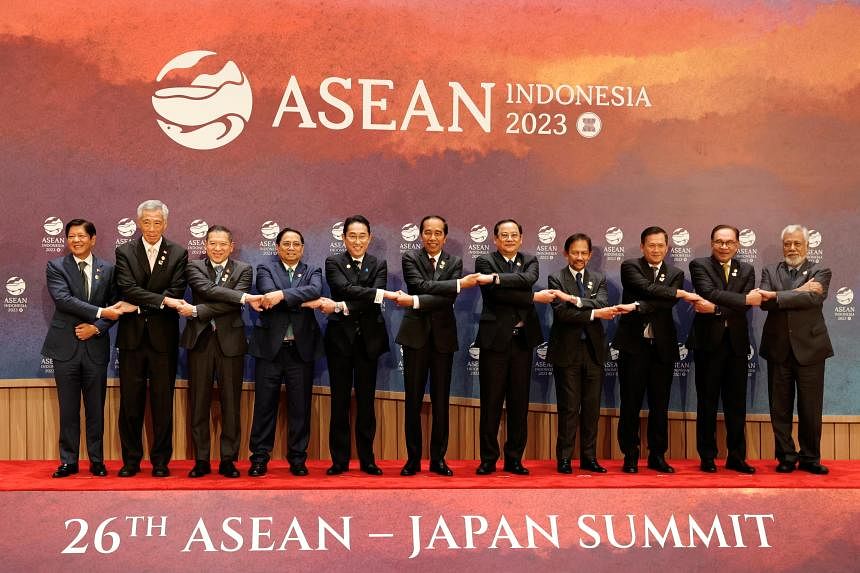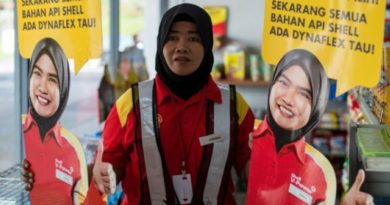25TH ASEAN-JAPAN SUMMIT | TOKYO – From foes to strategic partners: Japan, Asean to mark 50 years of ties with new action plan
 Asean and Japanese leaders at a summit in Indonesia in September 2023. The South-east Asian grouping has become a centre of global growth, but is facing internal and external challenges. PHOTO: REUTERS
Asean and Japanese leaders at a summit in Indonesia in September 2023. The South-east Asian grouping has become a centre of global growth, but is facing internal and external challenges. PHOTO: REUTERS..
.

TOKYO – Japanese and Asean leaders will cement their relationship as one of “trusted partners” during a three-day celebration in Tokyo from Dec 16 to mark 50 years of relations.
An action plan, expected to be announced on Dec 17, will spell out concrete steps that Japan and Asean will take in areas such as regional stability, the economy and social exchanges, according to a Japanese Foreign Ministry official.
“Asean has become a centre of global growth, but is facing internal and external challenges. Its members are diverse and hold various positions on global issues,” the official said during a media briefing on Dec 14.
“What we must do is work with Asean to find solutions to shared challenges and contribute to a peaceful, stable and prosperous region and the world. Our mutual trust is the foundation of our relations.”
Singapore’s Prime Minister Lee Hsien Loong will be among nine Asean leaders attending the commemorative summit, which will take stock of the progress of Japan-Asean ties over the last half-century and chart the way forward.
Myanmar, now under military rule since a coup against the civilian government in 2021, was not invited. Timor-Leste, however, will join as an observer, with Asean having agreed “in principle” to admit the country as its 11th member.
The semi-centennial also comes as Japan and Asean upgraded their relationship to the highest tier of a Comprehensive Strategic Partnership in September.
The leaders’ summit is expected to lead to closer cooperation in various areas, from supply chain resilience and digitalisation to decarbonisation and maritime capacity-building.
Fifty years ago, however, the mood could not have been more different. When Japan became the first country to establish dialogue channels with Asean in 1973, diplomatic tensions were high amid the Cold War and distrust was rife, with World War II in recent memory.
Antipathy towards Japan led to mass boycotts and protests in South-east Asia. Furthermore, its synthetic rubber exports threatened to cannibalise Asean’s natural rubber industry, leading to a synthetic rubber forum in 1973 to help soothe trade tensions.
This paved the way for the Fukuda Doctrine four years later, named after then Prime Minister Takeo Fukuda, which set out three principles that serve as a guide for Japan’s ties with Asean: It would never be a military power; it would establish “heart-to-heart” relations with Asean; and it would forge an equal partnership with Asean.
Since then, Japan and Asean have become equal partners politically, in the sense that neither would force the other into a certain political or strategic position even if they disagree, said Dr Kei Koga, an associate professor at Singapore’s Nanyang Technological University.
However, Japan’s status as an advanced economy and its ability to dole out economic aid meant there was a danger of a “patron-client relationship”, Dr Koga said.
Sensitive to this, Japan sought to transfer technical know-how with no strings attached. It contributed 20.25 trillion yen worth of overseas development assistance (ODA) to Asean from 1968 to 2022, through technical cooperation, low-interest loans and grants.
ODA projects have included infrastructure such as schools, hospitals, roads, bridges, dams and sewage systems. More recently, Japan extended soft loans to help tide several Asean member states over the Covid-19 pandemic.
This has generated goodwill, and today, Japan consistently ranks as Asean’s “most trusted” partner in the annual State of Southeast Asia survey by Singapore’s ISEAS-Yusof Ishak Institute.
“In the long run, this cooperation has helped each Asean member state with its socio-economic development, which in turn contributed to narrowing development gaps among Asean members,” Dr Koga said.
Now, fast-growing Asean is expected to leapfrog Japan by 2030 to become the world’s fourth-largest economy.
Conscious of this new dynamic, Japan in August set out an “economic co-creation vision” document that said it “needs to remodel its economic relationship with Asean”.
The Ministry of Economy, Trade and Industry said this would involve transforming from a relationship that has historically been focused on “one-sided” ODA, to one that promotes two-way innovation by respecting and leveraging the diversity of each country.
In diplomacy, Japan has consistently emphasised its commitment to Asean centrality in the regional political architecture, and stressed the affinity between its Free and Open Indo-Pacific vision and the Asean Outlook on the Indo-Pacific. Both lay out similar positions on regional cooperation, security and prosperity.
However, the big power strategic competition between the United States and China, as well as a more militarily assertive China in the region, has imposed unprecedented pressure on the notion of Asean non-alignment and centrality, said Professor Mie Oba of Kanagawa University.
Asean seems to be circumspect towards the Quad – a four-nation initiative comprising Australia, India, Japan and the US that has been labelled by China as an “Asian Nato”, referring to the North Atlantic Treaty Organisation alliance of 31 Western countries.
On the flip side, Asean is chary of China’s increasing presence and show of force in the disputed South China Sea.
“In order to maintain their autonomy and agency, it is important for non-great powers, including Japan and Asean, to cooperate in shaping a regional order by setting norms and rules,” Dr Koga said.
In this regard, Japan introduced a new overseas security assistance (OSA) framework in April to provide grants and non-lethal equipment to friendly armed forces in developing countries.
On Dec 16, Japan is expected to sign an OSA agreement with Malaysia, which will entail 400 million yen (S$3.7 million) worth of equipment including rescue boats and maritime surveillance drones.
Malaysia will be the second Asean recipient after the Philippines. Vietnam and Indonesia are also keen on receiving security aid.
Asean does not appear to be concerned about Japan’s domestic military build-up and the launch of its OSA framework, Professor Heng Yee Kuang of the Graduate School of Public Policy at The University of Tokyo told The Straits Times. He said this signals the grouping’s trust in Japan’s agenda-setting.
“Japan can explore the possibility of joint military exercises with Asean as a whole,” he said. While Japan has conducted drills with individual member states, a joint exercise involving the entire grouping has never been held.
With environmental concerns also high on the agenda, Asean leaders will attend a meeting of the Japan-led Asia Zero Emission Community initiative on Dec 18.
The framework recognises that there is no one-size-fits-all approach to decarbonisation, given the unique circumstances of each nation. Hence, the initiative advocates customised pathways for each country with a diverse range of energy sources and technologies.
A Japanese trade official said their meeting would pursue a “triple breakthrough idea of trying to simultaneously achieve decarbonisation, economic growth and energy security”.


 Memento Maxima Digital Marketing
Memento Maxima Digital Marketing








